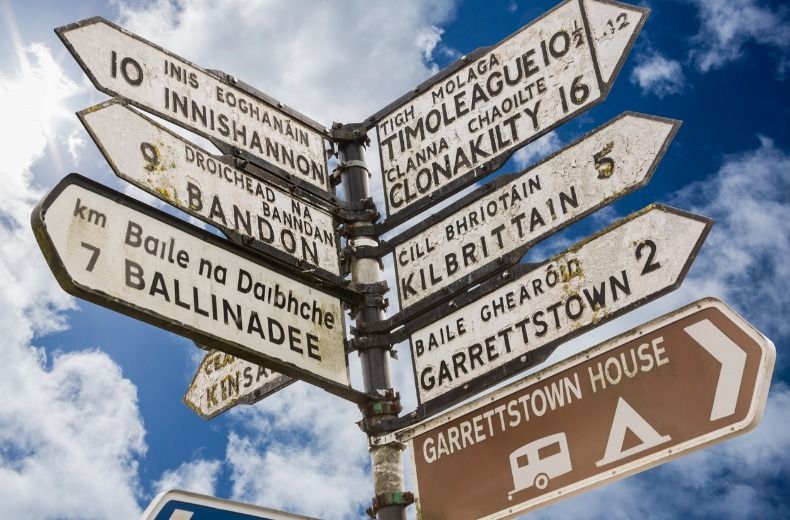Here, we run through some of the signs that you’ll encounter between Dublin and Donegal and everywhere in between. Make sure you swot up on your Irish road signs to ensure you don’t fall foul of the Garda (Irish police force).
Remember, many of the road signs will use the Irish language, or Gaelic, especially for place names. Read our handy guide for more tips for self-driving holidays in Ireland.
Read our driving in Europe guide for more.
'Speed limit' sign
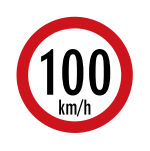
This one should cause little confusion because it looks almost identical to speed limit signs on this side of the Irish Sea, or across the border with Northern Ireland.
Look out for a familiar red circle with a speed indicated in large black text. The important thing to remember is that Irish speed limits are given in kilometres per hour (km/h) rather than miles per hour (mph). The signs should include ‘km/h’ as a handy reminder. Either way your dashboard should display speeds in both units of measurement.
See our helpful guide for more information on speed limits in Ireland.
Periodic speed limits
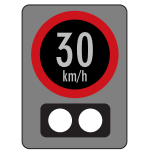
Some Irish speed limits only apply between certain times or on different days of the week. These should be clearly marked in one of two ways:
- a standard road sign with an information plate giving details of when the temporary rules apply.
- an electronic sign which only lights up when the periodic limit applies. This may feature two flashing amber lights.
‘National speed limit’ sign
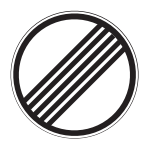
Ireland’s ‘national speed limit’ sign is very similar to the one in the UK. It uses the same white circle and a band of black stretching from the bottom left to the top right with one small difference: in Ireland, the black band is made of multiple stripes rather than a block of colour.
The key thing to remember is that the sign indicates a lower speed than the maximum speed on motorways:
- speed limit on national roads: 100 km/h (62 mph)
- national speed limit: 80 km/h (49mph)
‘Yield’ sign
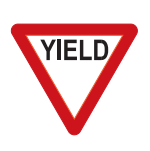
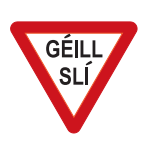
The first sign on our list that uses the Irish language. The words ‘Géill Slí’, ‘Yield’, or ‘Yield Right of Way’ appear in a triangular sign with a red border and work in the same way as ‘Give Way’ signs in the UK.
The sign usually appears next to a broken white line in the road and although it isn’t essential to stop your car before crossing the line, you must give way to approaching or crossing traffic, so you should slow down right away.
- Tips for self-driving holidays in Ireland
- Speed limits in Ireland: know the laws for your next road trip
- Driving in Europe checklist
‘No entry’ sign
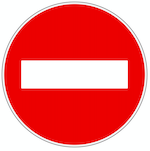
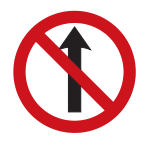
There are two types of ‘No entry’ sign in Ireland. The first looks identical to our ‘No entry for vehicular traffic’ sign and features a red circle with a horizontal white rectangle.
The second features an upward=pointing arrow overlayed by a diagonal red stripe on a white circle with a red border. Sometimes called the ‘No straight ahead’ sign, the design is sometimes used with a time limit or other restriction.
If you encounter either sign, you’ll have to avoid travelling on the signposted road and find an alternative route.
‘Two-way traffic’ sign
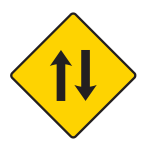
This sign appears on one-way streets when you’re approaching a road carrying two-way traffic. It looks very different to the triangular signs in the UK because of its diamond shape and yellow background.
If you see the sign, you should move over to the left of the road and anticipate cars travelling in the opposite direction.
‘Roundabout ahead’ sign
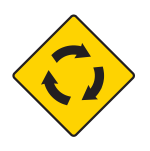
Another sign that ditches the red-and-white triangle used in the UK for a yellow diamond. The markings on the Irish sign are similar to those closer to home: three curved arrows arranged in a circular shape.
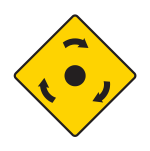
The ‘Mini roundabout’ sign uses the same yellow diamond. Look out for smaller curved arrows and a circle in the middle.
When approaching roundabouts and mini roundabouts you’ll need to give way to cars approaching from the right. It may be helpful to use Ireland’s Road Safety Authority’s (RSA) ‘golden rule’, where you think of the junctions as a clock.
If you’re taking an exit from the 6 o’clock or 12 o’clock position, you should approach the junction in the left-hand lane. If you’re taking an exit between the 12 o’clock and 6 o’clock positions, you should approach in the right-hand lane.

Instant cover available
• 24/7 rescue at the roadside
• Help to get home if your vehicle can't be fixed
• 5 star Defaqto rated cover

‘Series of dangerous bends’ sign
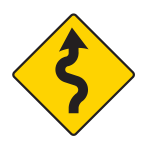
This distinctive sign is a common sight on scenic routes in Ireland like the Wild Atlantic Way. A black, snake-like arrow bending in multiple directions will appear on a yellow diamond to warn you to pay special attention to the layout of the road.
The signs may be used alongside speed humps to encourage you to maintain a safe speed.
‘School ahead’ sign
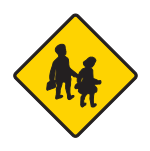
The ‘School ahead’ sign shows two figures in a yellow diamond with a black border. The sign might appear next to a periodic speed limit sign, or with amber lights, or both. It’s designed to help you pay extra attention to your speed and to look out for children walking or running unexpectedly into the road.
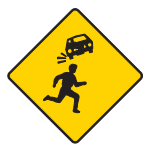
A similar ‘Children crossing’ sign might appear away from schools in residential areas. The sign features the image of a child running and a driver in a car in a diagonal position, seemingly slamming on its brakes. An accompanying sign reading ‘CAUTION CHILDREN’ or ‘Aire Leanaí’ may also appear.
‘Dangerous corner ahead’ sign
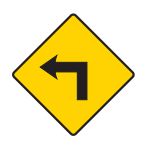
The ‘Dangerous corner ahead’ sign uses a right-angled arrow on a yellow diamond to warn drivers about a sharp turn in the road. It usually points in the direction of the corner to help you anticipate the layout of the road.
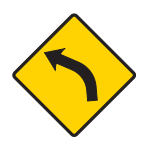
A similar ‘Dangerous bend ahead’ sign uses the same yellow diamond but a bent arrow.
When you see either sign, you should lower your speed and pay extra attention to the road and other vehicles around you.
‘Crossroads’ sign
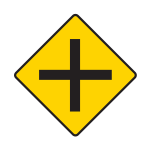
The ‘Crossroads’ sign uses the same yellow diamond and black border as other signs designed to ask motorists to drive more carefully.
A plus sign features in the centre, with lines made up of varying thicknesses and lengths. For example:
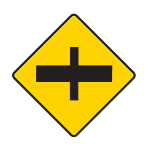
A thin vertical line intersected by a thicker horizontal line indicates a crossroad with a major road.
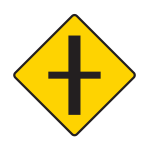
A longer, vertical line intersected by a thinner, horizontal line, indicates a road of less importance will appear ahead.
When turning right at a crossroads at the same time as a car coming from the opposite direction and also turning right, the RSA recommends that you try turning back-to-back. This way you and the other driver can see oncoming traffic and that traffic can see you.
Other crossroad signs include:
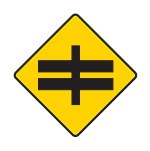
‘Crossroads with a dual carriageway’, where two horizontal lines are used.
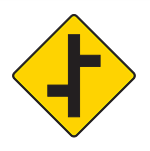
‘Staggered crossroads’, where intersecting roads appear at different sections of the road.
‘T-junction’ signs
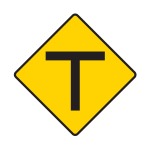
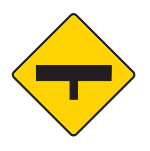
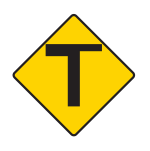
Warning signs for T-junctions feature a T-shape on a yellow diamond with a black border.
Like the crossroads signs, they use lines with different thicknesses to represent the importance of roads – thicker lines equal more important roads.
Sometimes, roads on one side of the horizonal line in the T appear thicker than others. Again, this is used to indicate the importance of roads.
- Driving in Ireland
- Driving abroad? Be prepared, take out European Breakdown Cover
- Driving in the EU after Brexit – everything you need to know
‘No stopping’ or ‘Clearway’ sign
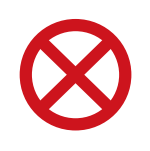
Irish ‘No stopping’ signs are very similar to equivalent signs in the UK. Rather than featuring a blue background, the red cross on a circular sign uses a white background.
The sign might appear next to a second sign to show that the no stopping rule applies at certain times only. These can also be written in Irish, for example: Luain - Aoine (Monday - Friday).
‘Max width’ and ‘Max height’ signs
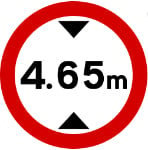
‘Max width’ and ‘max height’ signs differ from signs in the UK in one significant way. While UK signs include imperial (feet and inches) and metric (metres and centimetres) measurements, Irish signs only show measurements in metres and centimetres.
If you travel on a road where your vehicle exceeds the maximum height or width, you’ll be given a fixed penalty charge of €60.

Instant cover available
• 24/7 rescue at the roadside
• Help to get home if your vehicle can't be fixed
• 5 Star Defaqto rated cover


